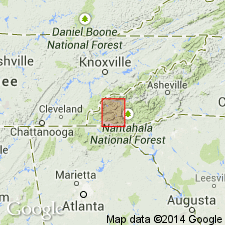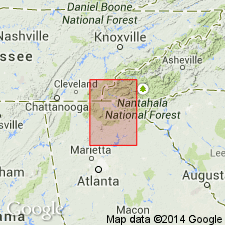
- Usage in publication:
-
- Tusquitee quartzite*
- Modifications:
-
- Named
- Dominant lithology:
-
- Quartzite
- AAPG geologic province:
-
- Piedmont-Blue Ridge province
Summary:
Tusquitee quartzite, named for exposures in Tusquitee Mountains of NC, is composed almost entirely of white quartzite and is of remarkably uniform appearance throughout all its areas. Composed of fine grains of rolled quartz sand. To north, west, and south of Marble, there are a few seams of fine conglomerate in the quartzite. On headwaters of Cheoah River some quartzites of medium grain contain slate pebbles of same nature as underlying Nantahala slate, but as a rule the grain of the rock is very fine. The beds of quartzite range in thickness from a few inches up to 2 or 3 ft. Interbedded with the quartzites are a few seams and layers of black slate and schist similar to those of underlying Nantahala slate. These are seldom over a foot thick. Thickness of formation ranges from 20 to 500 ft. Underlies Brasstown schist and overlies Nantahala slate.
Source: GNU records (USGS DDS-6; Reston GNULEX).

- Usage in publication:
-
- Tusquitee†
- Modifications:
-
- Abandoned
- AAPG geologic province:
-
- Piedmont-Blue Ridge province
Summary:
Authors propose that terms Tusquitee Quartzite and Tusquitee Member of Nantahala be abandoned following Hadley's (1970) suggestion. The two rock types, slate and quartzite, are interbedded throughout sequence and should be considered a single formation.
Source: GNU records (USGS DDS-6; Reston GNULEX).
For more information, please contact Nancy Stamm, Geologic Names Committee Secretary.
Asterisk (*) indicates published by U.S. Geological Survey authors.
"No current usage" (†) implies that a name has been abandoned or has fallen into disuse. Former usage and, if known, replacement name given in parentheses ( ).
Slash (/) indicates name conflicts with nomenclatural guidelines (CSN, 1933; ACSN, 1961, 1970; NACSN, 1983, 2005, 2021). May be explained within brackets ([ ]).

